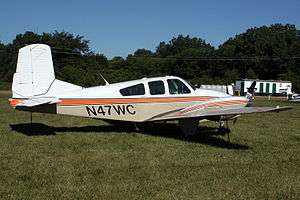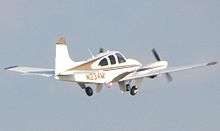Beechcraft Travel Air
| Model 95 Travel Air | |
|---|---|
 | |
| 1959 Model 95 at AirVenture 2008, Oshkosh, Wisconsin | |
| Role | Light twin aircraft |
| National origin | United States of America |
| Manufacturer | Beechcraft |
| First flight | 6 August 1956 [1] |
| Introduction | 1958 |
| Status | Out of production, in service |
| Produced | 1958–1968 |
| Number built | 720 |
| Unit cost |
$49,500 in 1959 |
| Developed from | Beechcraft Bonanza |
| Variants | Beechcraft Baron |
The Beechcraft Travel Air was a twin-engine development of the Beechcraft Bonanza. It was designed to fill the gap between the single engine Model 35 Bonanza and the much larger Model 50 Twin Bonanza, and ultimately served as the basis for its replacement, the Baron.[2]
Design and development

Designed as a competitor to the Cessna 310 and the Piper Apache, the Travel Air (developed as the Badger)[3] took many design features from previous Beechcraft airplanes.[4] It took its basic design from the Model 35 Bonanza,[5] fitted with the vertical stabilizer from the T-34 Mentor, and two four-cylinder engines. Its wing spar was borrowed from the large Model 50 Twin Bonanza, along with thicker gauge aluminum on the leading edge; landing gear systems had been taken from the United States Navy Mentor, which was a stronger structure built for training pilots for later aircraft carrier landings. Power came from, in the 1958 model year, two Lycoming O-360-A1A at 180 horsepower (130 kW) at 2700rpm each. With 75% power, the Travel Air was capable of 200mph at 7,500ft.[6]
Although developed and initially marketed as the Badger, a 1956 letter from the United States Air Force notified Beechcraft that the name had been previously chosen as a reporting name for the Soviet Tupolev Tu-16 bomber; therefore, Beechcraft elected to reuse the Travel Air name, which came from the predecessor company to Beechcraft, the Travel Air Manufacturing Company.[7] Beechcraft set in initial pricing of the Travel Air at $49,500; $10,450 below Cessna's 310 price, yet still $13,510 higher than Piper's Apache pricing.[7]
Variants
During its ten-year model run, between 1958 and 1968, the Travel Air saw four distinct variants emerge.
Model 95
The initial model was built for the 1958 and 1959 model years; the 1959 model had a fifth 'jumpseat' added. A total production of the 95 for 1958 and 1959 were 173 and 128, respectively.[2][8]
Model B95/B95A
Changes in the B95 version included a 19-inch (480 mm) cabin stretch to increase rear cabin area and the horizontal stabilizer and elevators were enlarged for better pitch control. A curved vertical stabilizer dorsal fairing is the most noticeable change. It also included a fifth seat, wider chord flaps, and an increased gross weight of 100 pounds. The 1961 Model B95A featured fuel injected Lycoming IO-360-B1A engines. A total 150 B95's were built in 1960, and 81 B95A's were built between 1961 and 1962 (serial numbers TD-453 through TD-533).[9] The 1960 model was priced at $51,500 and the 1961-62 model was priced at $49,500.[10]
Model D95A

In 1963 the Travel Air featured a larger rear window that is common with the Model A55/B55 Barons. The nose cone was lengthened for improved baggage space. Interior features such as the instrument panel, and heaters were redesigned. A total of 174 D95's between 1963 and 1967.[2][11]
Model E95
The E95 featured a one piece, 'speed-slope' windshield and a more pointed spinner design. The interior design was fully re-done. A total of 14 Model E95's were built in 1968; with pricing of $53,500.[12] The production drop off was due to the more costly but faster and powerful Model 55 Baron (developed from the Model 95, and initially designated Model 95-55). .[2]
Specifications (D95A)
Data from Janes's All The World's Aircraft 1965-66 [13][14]
General characteristics
- Crew: one
- Capacity: four passengers
- Length: 25 ft 11 in (7.90 m)
- Wingspan: 37 ft 10 in (11.53 m)
- Height: 9 ft 6 in. (2.90 m)
- Wing area: 199.2 sq. ft. (18.50 m²)
- Empty weight: 2,555 lb (1,159 kg)
- Max. takeoff weight: 4,200 lb (1,905 kg)
- Powerplant: 2 × Lycoming IO-360-B1B air-cooled flat-four, 180 hp (134 kW) each
Performance
- Never exceed speed: 209 knots (240 mph, 386 km/h)
- Maximum speed: 183 knots (210 mph, 338 km/h) at sea level
- Cruise speed: 170 knots (195 mph, 314 km/h) (economy cruise (65% power, 2,450rpm) at 11,000 ft (3,350 m))
- Stall speed: 61 knots (70 mph, 113 km/h) (flaps 28 degrees, gear down, zero thrust)
- Range: 1,017 nmi (1,170 mi, 1,880 km)
- Service ceiling: 18,100 ft (5,500 m)
- Rate of climb: 1,250 ft/min (6.3 m/s)
- Wing loading: 21.1 lb/sq ft (103 kg/m²)
See also
- Related development
- Aircraft of comparable role, configuration and era
References
| Wikimedia Commons has media related to Beechcraft Travel Air. |
- Notes
- ↑ Taylor 1965, p.182.
- 1 2 3 4 Phillips, Edward H., : Beechcraft - Staggerwing to Starship, page 62–63
- ↑ "Beech Badger - Light Twin". Flying. New York, New York: Ziff-Davis. October 1956. Retrieved October 17, 2014.
- ↑ Ball 1994, p.viii.
- ↑ Jacobshagen, Norman (October 1957). "FLYING Check Pilot Report on the Beechcraft Travel Air". Flying. New York, New York: Ziff-Davis. Retrieved October 17, 2014.
- ↑ Ball 1994, p.2.
- 1 2 Ball 1994, p.x.
- ↑ Ball 1994, p.13.
- ↑ Ball 1994, p.17, 21, 25.
- ↑ Ball 1994, p.21, 25.
- ↑ Ball 1994, p.29, 45.
- ↑ Ball 1994, p.48.
- ↑ Taylor 1965, pp. 182–183.
- ↑ Ball 1994, p.30, 31.
- Bibliography
- Ball, Larry A: From Travel Air to Baron...How Beech Created a Classic, Ball Publications, 1994. ISBN 0-9641514-0-5
- Phillips, Edward H., : Beechcraft - Staggerwing to Starship, Flying Books, 1987. ISBN 0-911139-06-0.
- Taylor, John W. R. Jane's All The World's Aircraft 1965-66. London: Samson Low, Marston, 1965.